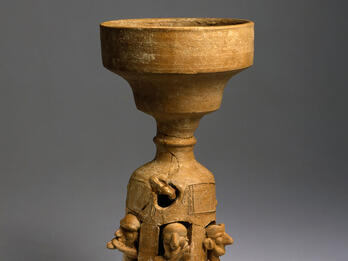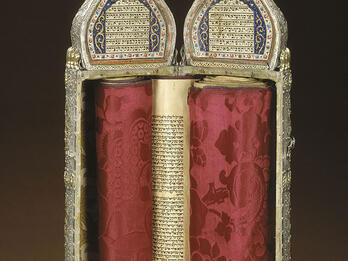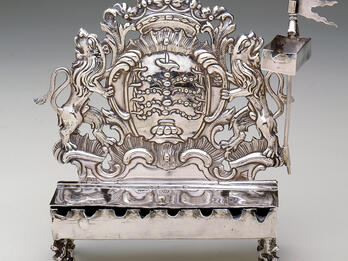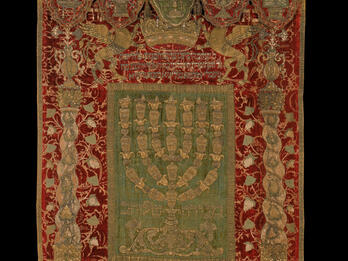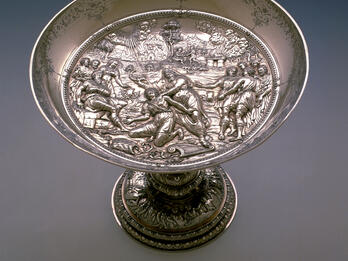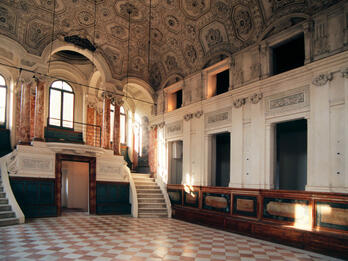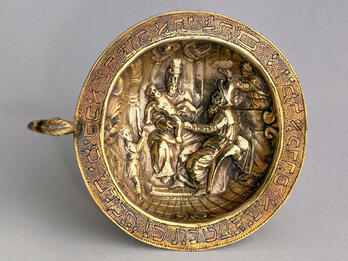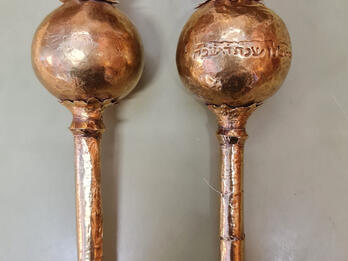Showing Results 1 - 10 of 83
Restricted
Image
Musicians on ritual stand, Ashdod, late 11th or early 10th century BCE. Music and dance played an important role in Israel and the ancient Near East in both daily life and special occasions such as…
Places:
Ashdod, Land of Israel (Tel Ashdod, Israel)
Date:
Iron Age I, Late 11th or Early 10th Century BCE
Subjects:
Categories:
Restricted
Image
The origin of this Torah scroll is in Turkey. It was donated by the Camondo family, one of the most important Jewish families in Istanbul, many of whose members settled in Paris and greatly…
Contributor:
Artist Unknown
Places:
Ottoman Empire (Turkey)
Date:
1860
Subjects:
Categories:
Public Access
Image
The master silversmith Rötger Herfurth was particularly well known for his Hanukkah lamps, most of which have backplates and rampant lions, a style he popularized and which came to be known as the…
Contributor:
Rötger Herfurth
Places:
Frankfurt am Main, Holy Roman Empire (Frankfurt am Main, Germany)
Date:
ca. 1769–1776
Subjects:
Categories:
Public Access
Image
Although few examples of the work of embroiderer Jacob Koppel Gans remain, he is best known for this Torah ark curtain and valance, dating to 1772 or 1773, made of velvet and embroidered with metallic…
Contributor:
Jacob Koppel Gans
Places:
Holy Roman Empire (Bavaria, Germany)
Date:
1772–1773
Subjects:
Categories:
Restricted
Image
The purpose of the Torah crown is visually to augment the status of the Torah scroll, emphasizing its importance and centrality to Jewish life. These magnificent silver ornaments are placed over the…
Contributor:
Wilhelmus Angenendt
Places:
Amsterdam, Dutch Republic (Amsterdam, Netherlands)
Date:
1809
Subjects:
Categories:
Public Access
Image
This Purim charity plate was made in Dordrecht in the Netherlands between 1590 and 1611. It was used by Jews living in The Hague.
Contributor:
Artist Unknown
Places:
Dordrecht, Dutch Republic (Dordrecht, Netherlands)
Date:
1590–1611
Subjects:
Categories:
Public Access
Image
This Torah ark, installed in a synagogue in the Italian town of Urbino, is a fine example of Renaissance Judaica. Carved from walnut in the early sixteenth century, the ark belonged to the Sephardic…
Contributor:
Artist Unknown
Places:
Urbino, Duchy of Urbino (Urbino, Italy)
Date:
ca. 1500
Subjects:
Categories:
Restricted
Image
Home to a Jewish community from at least the thirteenth century, Pesaro later became the refuge of Portuguese and Spanish Jews in the sixteenth century. In 1642, a few years after the town’s Jews were…
Contributor:
Angelo Scoccianti, Artist Unknown
Places:
Pesaro, Duchy of Urbino (Pesaro, Italy)
Date:
Late 16th Century
Subjects:
Categories:
Restricted
Image
This silver plate from Padua, Italy, was made for use in the brit milah, the circumcision ritual celebrated when a baby boy is eight days old. In this detailed depiction of the ritual, the baby seems…
Contributor:
Artist Unknown
Places:
Padua, Venice (Padua, Italy)
Date:
17th Century
Subjects:
Categories:
Public Access
Image
These Torah finials from Cochin, India, were made around 1565. Elegant and simple, crafted from metal, their surfaces appear to be hammered, with one adorned with a Hebrew inscription. The earliest…
Contributor:
Artist Unknown
Places:
Cochin, Cochin (Ernakulam, India)
Date:
ca. 1565


